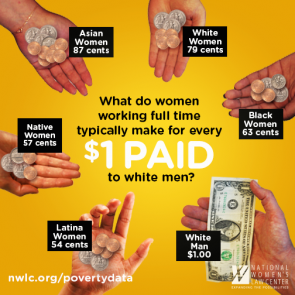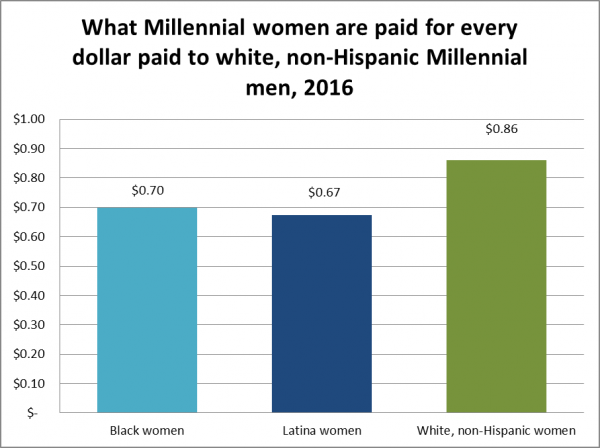Abortion rights, women of color, and LGBTQI+ people are under attack. Pledge to join us in fighting for gender justice.
Why We Can’t Whitewash the Wage Gap

According to recent poverty, income, and health insurance data released by the U.S. Census Bureau, the overall gender wage gap for 2016 is holding steady at 80 cents. However, the wage gap for white women closed by 4 cents, a statistically significant change from last year. In other words, in 2016 white, non-Hispanic women went from making 75 cents to 79 cents for every white, non-Hispanic man’s dollar. That’s great news, but we still have some serious work to do on the pay equality front, especially if we take a closer look at how women of color fared last year.

The numbers illustrated above are grim: compared to every dollar a white, non-Hispanic man makes, Black women make 63 cents, Native women make 57 cents, and Latina women make a dismal 54 cents. Played out over an entire career, women of color are losing hundreds of thousands of dollars in potential income.

As the wage gap between white, non-Hispanic women and men closes, the disparity between white, non-Hispanic women and women of color grows larger, and this should be a cause for concern. Seeking solutions to this problem means clearly articulating some of the factors at play in maintaining this sexist and racist wage gap.
The wage gap starts immediately. Just in case you Millennials out there thought you were exempt, think again. While the wage gap is smaller for younger women, the data shows that it begins right when women enter the labor force. Millennial women of color (ages 18-34) who work full-time, year-round are already falling behind their white, non-Hispanic male peers. Perhaps unsurprisingly, white, non-Hispanic Millennial women fare better than Millennial women of color, making 86 cents for every dollar white, non-Hispanic Millennial men make. But Black Millennial women make 70 cents and Latina women make 67 cents, respectively, compared to white, non-Hispanic Millennial men.

The wage gap exists across occupations. The argument that women are simply choosing lower paying jobs doesn’t fly: a wage gap exists in 98 percent of occupations. Not only is there a concentration of women in low-paying jobs (or jobs that typically pay less than $11 per hour), but nearly half of low-wage women workers are women of color. These low-wage jobs exacerbate the effects of the wage gap in the lives of women of color.
Throwing motherhood into the mix makes things more complex. Mothers in the paid workforce commonly take on jobs in the service industry (i.e., retail, housekeeping, waitresses, and customer service) and get paid less than fathers doing the exact same job. The wage gap doesn’t discriminate by geography either, as data shows mothers experiencing the wage gap in every single state.
What’s a double whammy? Single mothers must support their families on a single income depressed by the motherhood wage gap, and women of color are particularly likely to be single mothers–and must do with even less. Based on recent data, 38.8 percent of Black female-headed families with children and 40.8 percent of Latina female-headed families live in poverty.
Working full time while also shouldering the responsibility to care for sick children and family members takes a toll on women. Issues like unpredictable work scheduling, no paid leave, and a federal minimum wage that has gone unchanged for over a decade make single motherhood even more difficult. Let’s not even talk about the exorbitant costs of high quality child care.
While progress has been made in closing the wage gap for white women, women of color are being left behind. Moving forward, smart and inclusive policies must address the sexist and racist dimensions of the wage gap.

